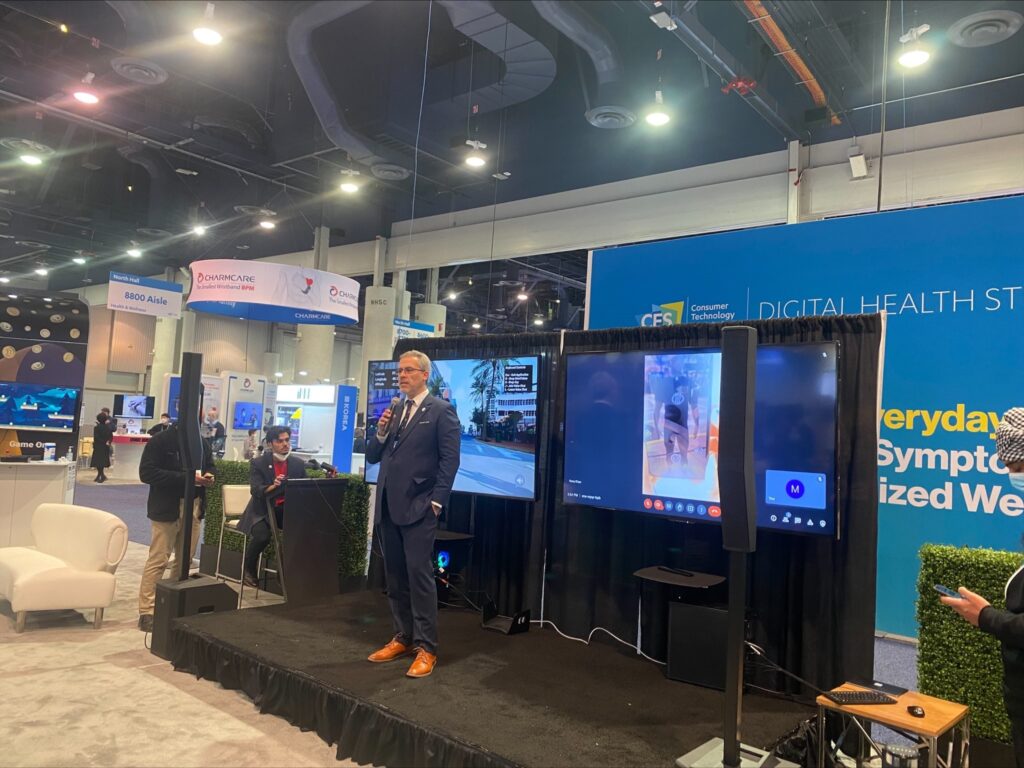Every year, CES gives tech companies the chance to showcase their latest inventions and innovations related to consumer tech. As always, a few key themes ran throughout the event, and this year it was most notably the metaverse. Transmira’s Omniscape XR platform, built on the BSV blockchain, ranked in the top three innovations this year. That’s quite an achievement!
What is Transmira’s Omniscape?
Omniscape is an XR platform that allows users to monetize digital real estate. Think of it like this; you buy a location in the metaverse, and you earn revenue from paid augmented reality content and advertising.
Omniscape’s slogan paints the picture nicely: location is the new domain name. In the metaverse, those who buy these locations early will benefit most, like those who bought land in Manhattan before it was developed.
Here are a few key features of Omniscape:
- Locations can be sold and traded in a virtual marketplace. As they are developed, they gain in value, just like real estate in the ‘real world.’
- Users can claim the area where their business is located for free. They can then take control of the airspace above it. There’s even a ‘No-AR’ registry coming soon.
- Locations being like domain names, they’re registered for two years before the renewal comes up. If they expire, they go back onto the marketplace.
For those confused by all this talk of the metaverse and what it means, Omniscape is a simple and easy-to-understand glimpse that showcases what it’s all about. A whole new virtual reality world is being created, and like in the real world, it will be possible to own parcels of land that become more (or less) valuable with time.
“Omniscape is a metaverse platform for the real world. We go beyond social VR worlds and novelty AR experiences by linking real locations and objects to their digital counterparts. From virtual goods and 3D NFTs to city-scale digital twins, we are creating new ways to experience the world around us with metaverse technologies,” Robert Rice, founder and CEO of Transmira, told CoinGeek.
Transmira CEO and founder Robert Rice at CES 2022
The metaverse on Bitcoin SV
It’s great to see a native Bitcoin SV application recognized at the CES awards. This will draw more attention to the world’s largest public utility blockchain.
The truth is, while there’s much talk about the metaverse all across the digital currency and blockchain industries, as things stand, it’s only going to work at scale on BSV. To understand why, think about how the metaverse will function once it really takes off. It’s going to require a way to keep track of digital items and ownership, which BSV blockchain is perfect for since it keeps everything on-chain, and it’s going to need the blockchain it’s built on to scale infinitely as the number of users explodes.
Right now, BSV is processing over 4 million daily transactions. It can handle 50,000+ transactions per second, and that’s just the warm-up lap. With BSV’s limitless block sizes, there’s no ceiling as to how many transactions it can handle. The same can’t be said of BSV’s competitors, and layer two scaling solutions will cause problems with keeping track of the digital items that power the metaverse if they work at all.
As for fees, transactions on BSV cost $0.0004 on average. It’s these low fees that will make the metaverse accessible to all, and that will allow for micropayments to become the fuel it runs on. Imagine receiving a $0.001 fee every time someone interacts with your location in Omniscape, and you’ll begin to understand why both BSV is the only choice and why ad monopolies platforms are scrambling to try to build a metaverse they control before being disrupted.
The beginning of recognition for BSV
In 2021, as Dr. Craig Wright wiped the floor with his opponents in a high-profile court case in Florida, the first cracks in the narrative against BSV began to show.
As innovative and market-leading products like Transmira’s Omniscape win recognition going forward, BSV is going to enjoy increased attention, and it’s ready to shine right now. With Teranode on the horizon and more transactions than most other blockchains combined, even in these early stages, BSV is the most likely contender to win the blockchain-metaverse battle when serious companies and developers begin to build out their products.
“BSV Blockchain is the ultimate blockchain for the Metaverse, with industry leading transaction volume, speed, scalability, and cost-effectiveness,” Rice said.
There’s no turning back—the metaverse is coming
There’s no going back now; the metaverse genie is out of the bottle. However, many still have not realized that the metaverse is just a small part of the transformation that’s coming. Yes, VR worlds will emerge, and they’ll be fueled by micropayments, but the traditional internet is going to change, too. To learn more about that, read this post on the Metanet.
Watch: CoinGeek Weekly livestream coverage of CES Day 1
Watch: CoinGeek Weekly livestream coverage of CES Day 2
Watch: CoinGeek Weekly livestream coverage of CES Day 3
New to Bitcoin? Check out CoinGeek’s Bitcoin for Beginners section, the ultimate resource guide to learn more about Bitcoin—as originally envisioned by Satoshi Nakamoto—and blockchain.






